
Journal of Cutaneous Immunology and Allergy
Scope & Guideline
Connecting experts to enhance the dialogue in dermatology and immunology.
Introduction
Aims and Scopes
- Dermatological Immunology:
The journal extensively covers studies on the immune responses related to skin diseases, including autoimmune conditions, allergic reactions, and inflammatory skin disorders. - Clinical Trials and Case Reports:
A significant portion of the journal comprises clinical trials and case reports that provide insights into the efficacy and safety of new treatments and therapies for various skin conditions. - Pathophysiology of Skin Disorders:
Research focusing on the underlying mechanisms of skin diseases, including genetic, environmental, and immunological factors, is a core area of interest. - Patient-Reported Outcomes and Quality of Life:
The journal emphasizes the importance of patient perspectives, exploring how skin conditions affect quality of life and treatment satisfaction. - Emerging Therapies and Treatments:
It highlights novel therapeutic approaches in dermatology, particularly biologics and targeted therapies for chronic skin diseases such as atopic dermatitis and psoriasis.
Trending and Emerging
- Biologics and Targeted Therapies:
There is a rising trend in studies related to biologic treatments for chronic skin conditions, particularly atopic dermatitis and psoriasis, reflecting their increasing importance in clinical practice. - Patient-Centric Research:
Research focusing on patient-reported outcomes, quality of life, and the psychosocial impacts of skin diseases is gaining traction, emphasizing a holistic approach to treatment. - Real-World Evidence:
A growing number of studies are dedicated to real-world evidence, assessing the effectiveness and safety of treatments in everyday clinical settings, which is crucial for informing practice. - Genetic and Molecular Insights:
Emerging research is delving into the genetic and molecular underpinnings of skin diseases, enhancing the understanding of pathophysiology and potential targeted interventions. - Impact of COVID-19 on Dermatological Conditions:
The pandemic has led to increased research into skin manifestations related to COVID-19 and the effects of vaccinations on skin health, indicating a timely adaptation to global health issues.
Declining or Waning
- Traditional Dermatological Treatments:
There is a noticeable decline in research focused on conventional dermatological treatments, such as topical corticosteroids, as newer biologic therapies gain prominence. - Basic Science Studies:
Research centered on basic science and laboratory studies, while still important, appears less frequently as the journal shifts towards more clinical applications and real-world effectiveness. - General Allergy Research:
The focus on general allergy research is diminishing, with a more concentrated interest in specific skin-related allergic responses rather than broader allergy topics.
Similar Journals

ANAIS BRASILEIROS DE DERMATOLOGIA
Advancing Dermatological Knowledge, One Article at a Time.ANAIS BRASILEIROS DE DERMATOLOGIA is a prestigious academic journal published by Elsevier Science Inc, specializing in the dynamic field of dermatology. With its Open Access model established in 2002, this journal ensures wide dissemination of research findings and facilitates collaboration within the dermatological community. Hailing from Brazil, it provides a platform for innovative research from both local and international contributors, spanning from its inception in 1963 to the current year, 2024. The journal positions itself as a vital resource in the dermatology sphere, currently ranked in the Q3 category for dermatology and holding a notable rank of 71 out of 142 in the Scopus rankings, placing it in the 50th percentile for its field. With a commitment to advancing knowledge and practice in dermatology, ANAIS BRASILEIROS DE DERMATOLOGIA is an essential read for researchers, professionals, and students eager to explore contemporary advancements and clinical practices.
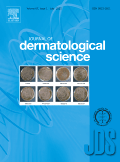
JOURNAL OF DERMATOLOGICAL SCIENCE
Unveiling the Science Behind Skin HealthThe Journal of Dermatological Science is a premier peer-reviewed publication dedicated to advancing knowledge in the field of dermatology, biochemistry, and molecular biology. Established in 1990 and published by Elsevier Ireland Ltd, this esteemed journal has consistently achieved high academic recognition, securing a Q1 ranking in Dermatology and a Q2 ranking in both Biochemistry and Molecular Biology as of 2023. With a notable impact factor and a Scopus rank that places it within the top tier of dermatology journals globally, it serves as a critical platform for researchers, clinicians, and academicians to disseminate their findings and foster innovation in skin health and disease management. Although the journal is not open access, it provides essential insights into cutting-edge research, clinical practices, and molecular mechanisms underlying dermatological conditions. The Journal of Dermatological Science is not only a vital resource for high-quality articles but also a driving force in shaping the future landscape of dermatological research.

JOURNAL OF THE AMERICAN ACADEMY OF DERMATOLOGY
Advancing dermatological knowledge since 1979.JOURNAL OF THE AMERICAN ACADEMY OF DERMATOLOGY, published by Mosby-Elsevier, stands at the forefront of dermatological research and education. With an impressive impact factor and categorized as Q1 in Dermatology, this journal has established itself as a pivotal resource for healthcare professionals and researchers in the field. Since its inception in 1979, it has provided a platform for high-quality peer-reviewed articles, contributing significantly to advancements in dermatological science and practice through 2024. The journal commands an honorable position, ranking #8 out of 142 in the Scopus database's medicine dermatology category, placing it in the 94th percentile among its peers. Readers can access a wealth of cutting-edge studies, case reports, and reviews that address a broad spectrum of topics, from clinical dermatology to emerging therapies. In addition, the journal's commitment to excellence ensures it remains an essential tool for students, clinicians, and researchers dedicated to improving skin health and furthering knowledge in dermatology.
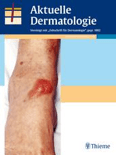
AKTUELLE DERMATOLOGIE
Pioneering Research in the World of DermatologyAKTUELLE DERMATOLOGIE is a distinguished journal in the field of Dermatology, published by GEORG THIEME VERLAG KG in Germany. With a commitment to advancing knowledge and practice in dermatological science, the journal has regularly featured research articles, reviews, and case studies since its inception in 1975 and continues to publish contributions through 2024. Despite being categorized in the lower quartile (Q4) of dermatology journals and holding a Scopus rank of #127 out of 142, it plays a pivotal role in disseminating valuable insights that support ongoing education and research in the discipline. The journal provides an essential platform for both seasoned professionals and budding researchers to share their findings, explore emerging trends, and discuss clinical practices, all while serving the needs of an evolving medical landscape. Access to its content may be restricted, but the journal remains a crucial reference for those invested in the future of dermatological research and patient care.

AIMS Allergy and Immunology
Advancing the Frontiers of Allergy and ImmunologyAIMS Allergy and Immunology is a prestigious open access journal dedicated to advancing knowledge in the fields of allergy and immunology. Published by the American Institute of Mathematical Sciences (AIMS), this journal provides a vibrant platform for researchers, practitioners, and scholars to share groundbreaking findings and insights. Recognized for its commitment to disseminating high-quality research since its inception in 2017, AIMS Allergy and Immunology contributes significantly to the understanding of complex immunological mechanisms and allergic responses, thus playing a pivotal role in enhancing clinical practices and therapeutic strategies. With its ISSN 2575-615X, the journal aims to facilitate a robust exchange of ideas and promote collaboration within the scientific community. Researchers and practitioners are encouraged to access the latest studies and reviews, which are all freely available online, ensuring that vital information reaches a global audience without barriers. Together, we can tackle the challenges posed by allergies and immune disorders through rigorous scientific inquiry and innovation.
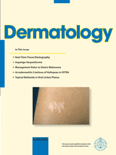
DERMATOLOGY
Advancing dermatological science for a healthier tomorrow.DERMATOLOGY, an esteemed journal published by KARGER, is a vital resource in the field of dermatological research and clinical practice. Established in 1893, with its comprehensive coverage extending to 2024, this journal has earned its place as a leading publication, holding a prestigious Q1 quartile ranking in Dermatology and ranking 15th out of 142 in the Scopus Medicine - Dermatology category, reflecting its 89th percentile standing within the discipline. The journal aims to disseminate innovative research findings, critical reviews, and clinical studies that advance the understanding of skin disorders and their treatments. While primarily available through institutional subscriptions, DERMATOLOGY remains committed to enhancing accessibility and fostering international collaboration among researchers, professionals, and students in the dermatological community. Its rigorous peer-review process guarantees the highest quality of published works, making it an essential reference for those dedicated to advancing dermatological science and improving patient care.
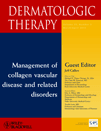
Dermatologic Therapy
Exploring the complexities of dermatology for better patient outcomes.Dermatologic Therapy is a leading peer-reviewed journal published by WILEY-HINDAWI that focuses on the multifaceted field of dermatology. Established in 1996 and continuing its profound impact into 2024, the journal has earned an impressive Q1 rating in Dermatology and ranks 11th out of 142 in the Scopus categorization, placing it in the 92nd percentile. With its headquarters in the United Kingdom, the journal's mission is to advance the understanding and treatment of skin diseases through the dissemination of high-quality research, reviews, and clinical information. Although not an open-access journal, it provides extensive access options to ensure that vital research reaches its audience. By leading scholarly discourse and innovation in dermatological treatments, Dermatologic Therapy serves as an essential resource for researchers, clinicians, and students dedicated to improving skin health worldwide.
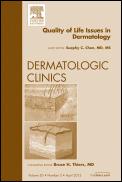
DERMATOLOGIC CLINICS
Elevating Standards in Dermatologic Education and PracticeDERMATOLOGIC CLINICS is a leading journal in the field of dermatology, published by W B SAUNDERS CO-ELSEVIER INC. Since its inception in 1983, the journal has consistently provided a platform for the dissemination of high-quality research and clinical insights, earning its place in the prestigious Q1 quartile for dermatology in 2023. With a Scopus ranking of #34 out of 142 in its category and a commendable 76th percentile, DERMATOLOGIC CLINICS remains essential reading for clinicians, researchers, and students alike. The journal features comprehensive reviews and original articles that address the latest advancements and challenges in dermatologic diagnostics and treatments. Though it does not offer Open Access, it is widely accessible ensuring a broad readership. With a commitment to advancing the understanding of skin disorders, DERMATOLOGIC CLINICS continues to uphold its legacy of excellence in dermatological scholarship.
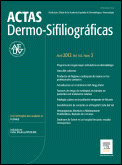
Actas Dermo-Sifiliograficas
Unlocking the Future of Skin Research and PracticeActas Dermo-Sifiliograficas, published by Elsevier España, stands as a pivotal resource in the realms of dermatology, histology, and pathology and forensic medicine. With its ISSN of 0001-7310 and E-ISSN 1578-2190, this esteemed journal has transitioned to an Open Access model since 2020, facilitating broader dissemination of impactful research. Operating from its Madrid headquarters, it has been a vital platform for scholarly exchange since its inception in 1945, continuing through its converged years until 2024. The journal holds a Q3 ranking in dermatology, histology, and pathology and forensic medicine as of 2023, reflecting its relevance in the academic community where it ranks 79th in dermatology and 126th in pathology among its peers. With a commitment to advancing knowledge and practice in its fields, Actas Dermo-Sifiliograficas serves as an essential repository for researchers, professionals, and students seeking to engage with the latest findings and innovative perspectives in skin and disease research.
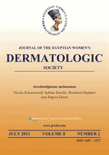
Journal of Egyptian Womens Dermatological Society
Empowering Women's Health Through Dermatological ResearchThe Journal of Egyptian Women's Dermatological Society, published by Wolters Kluwer Medknow Publications, is an essential platform dedicated to advancing the field of dermatology through a valuable focus on women's health issues. Established to provide an open access outlet since 2019, this journal aims to disseminate research, case studies, and reviews that address the unique dermatological needs and concerns of women, particularly in the Egyptian context. Despite its current ranking in the Q4 category in dermatology and a Scopus rank of #117 out of 142 with a 17th percentile, the journal serves a critical role in fostering scholarly communication among researchers, clinicians, and academicians. With a commitment to promoting knowledge advancement and community engagement, this journal invites submissions that align with its objectives, specifically geared towards empirical research and innovative practices in dermatology impacting women's health.